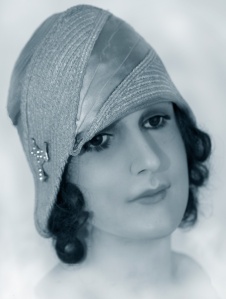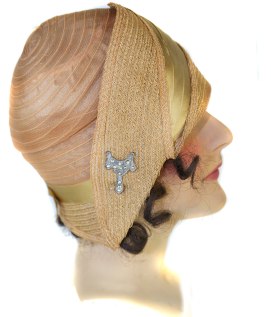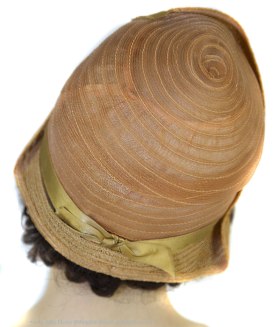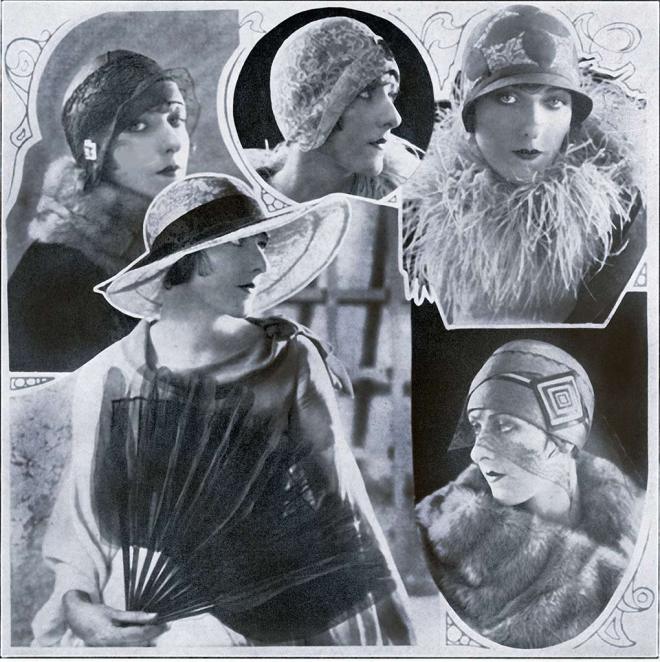

The overall image of The Flapper during the Roaring Twenties is one that most anyone can envision. Flappers wore short hair, slinky silk dresses often covered with glistening beaded fringe and rhinestone bling. They had careers, or at least a job, and many drove automobiles. At night, the women met at secret speakeasies where they danced the Charleston, drank alcohol and smoked using glamorous, long bakelite cigarette holders. Their twinkling metallic purses carried their own money, lipstick and crimson rouge…but most of all, a flapper always wore a hat.
It was a particular kind of hat. Called a cloche due to the bell-shaped silhouette, the hat was styled to tightly hug the head. In fact, cloches were often so tightly fitted, that the wearer had to struggle for a second or two in order to pop the hat down over her ears.
A cloche was often pulled down so far over the head that one could barely see both eyebrows, which were pencil thin and plucked away almost entirely. This low riding hat emphasized the eyes, which were usually darkly shadowed with make-up.
“It’s the brim that makes the hat alluring, following the trail of the eyebrow.”

Throughout the 1920s, the dimensions of the brims changed the look of a cloche, but it was a necessity in design to keep that deep eyebrow skimming line. Knees could be seen, but foreheads were covered.
Cloches are one way of accurately dating and documenting photographs and illustrations from that era. Whether wide brims, angled brims or no brims; the type of materials, hand-embroidery, beaded and even hand-painted designs on cloches may be used to accurately track down the year or even the very month to when the hat was sold. Cloche design motifs and patterns were heavily reported during the 1920s in newspapers, magazines and trade publications. A 1920’s cloche was the ultimate personal statement of who a woman was.
According to “The Illustrated Milliner” vol 29 May 1928, it was necessary to have a cloche with a brim of some kind for the spring and summer of that year. While many brims flared out to create a true big-bell design silhouette, there were tightly fitting cloches with brims that were folded up and stitched against the crown of the hat. Although this may seem like a brimless hat, it was not described as such during 1928.
The Illustrated Milliner’s editor decreed, “Every hat must have a brim, even helmets and toques, the verdict of Paris.” One the new “up-over-one-eye hats” favored at the Paris shows that year “was made from knitted, super-fine jersey straw.” These were worn by “the smartest of smart women. At luncheon yesterday at the Ritz I counted twenty of them, each in a different color scheme.”
Cloche styled hats rank historically as one of the most artistic and creative accessory designs in fashion history. Elaborate trims were created by milliners who worked at their salons like artists sculpting in their studios. Many trims were easily changed out so that the hat design could match any number of dresses. Women had personal ways of adorning their hats and often used rhinestone or bakelite brooches, although wealthy women did not hesitate to pin on a diamond or two.

Colors for cloche styles were chosen by the millinery industry’s Allied Millinery Association and were carefully reported on in the May issue of “The Illustrated Milliner.” Since it was practical to say that every single woman in the United States owned at least one hat during 1928, even the simplest mention of color made a huge impact on the fashion market.
According to guest fashion journalist Margaret Hayden Rorke, managing director of The Textile Color Card Association of the USA, the ten colors chosen for summer 1928 included:
“CORNSILK: a mellow yellow, the color of that fluffy silken tassel that so proudly bedecks the ripped corn.”
“LUCERNE BLUE: a light, dulcet violet tinted blue, like…azure waters of that…Swiss lake mirroring the dome of the sky….”
“BELLEEK: A delicate, intriguing off-white shade, is that creamy tint of eggshell porcelain called Belleek, which for so many years Ireland has made famous.”
“LILY GREEN: Is a delightful shade, light in value with just enough yellow in its composition to add verve.”

“TRIUMPH BLUE: Is a medium blue very rich in tone, slightly greenish in cast…. It’s the blue of the sky in its first mood of twilight, and is named in honor of Lindbergh’s triumphant flight.”
“GULL: A pale grey of slightly rosy cast, is the sparkling color of the seagull’s wings as it flies from the crest of a wave up to the sun.”
“CASTILION RED: That vivacious, scintillating hue of Old Spain, suggestive of flashing dark eyes, a fan and a mantilla – the color that Goya…so deftly applied to high-light his canvasses.”
“PEACHBEIGE: …a beige with a peach-bluish tone, so becoming to all types of femininity.”
“PINE FROST: Another charming green – one of the new Shadow Shades, is a silvery grey-green shade, for all the world like frost glistening on stately pine trees.”
“DIADEM: A tender orchid shade…a royal shade as beautiful as the delicate tinted dahlia…from which its name is borrowed.”
Cloches are pictured in nearly every publication during this period. Photographs depict millinery models wearing cloches styled with furs, various types of ostrich boas or while holding huge “petal” fans made from silk marquisette (a wispy meshed fabric) stretched across bakelite sticks.
Obviously, fashion designers working during the The Roaring Twenties were nearly at their ultimate pitch in glamour that summer.
The fashion industry would continue to produce luxurious fashions…one topping the next, for just about another year.
Then…on an autumn day dated October 29, 1929…a historic day coined Black Tuesday…the stock market crashed…and the fabulous fashions and glam of the Roaring Twenties essentially ended.

Original text & photographs ©2014 Julia Henri
Please use citations and references to The Gilded Times.
http://www.thegildedtimes.wordpress.com
http://www.thegildedtimes.com
Enjoyed this post … so informative … thanks!
Hello! Thank you! I so very appreciative! Thank you for Following my work…as you can see, this blog is still a fledgling but with an exciting future! Please let me know your favorite era or if you’re looking forward to a particular topic. Best ever!!! Julia
Your mannequin is exquisite! What incredible eyes she has. I also enjoyed the prior blog entry on 9 Cities – it must have been so exciting for those fashion journalists to travel by train across the country.
Mary, thank you so very much once again. I appreciate that you are reading the posts and so very glad you’re enjoying them. We will be moving into a new decade this week…so another post will along soon! Thanks again!